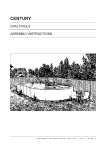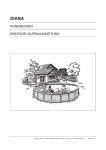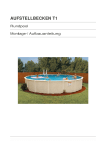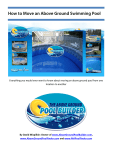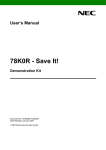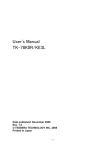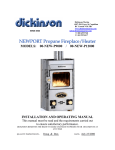Download ROUND Pools CENTURY Operating instructions
Transcript
CENTURY Round Pools ASSEMBLY INSTRUCTIONS ASSEMBLY INSTRUCTIONS CENTURY - ROUND - page 1 Installation Instructions 3.Do not attempt to lift the heavy boxes by yourself. To HOW TO USE THESE INSTRUCTIONS Be sure to read these instructions completely before reduce the possibility of personal injury, have someone help you move heavy boxes (pool wall, liner, etc.). beginning the installation of your pool. ATTENTION: warning Always use these assembly instructions to install 1.Your pool must be level within 2-3 cm all around. your swimming pool. Ignore any English instructions An unlevel pool may cause excessive stress on included with the pool, as the size will be in inches, etc. the pool frame. A pool which is not level may ATTENTION: Check the pool parts with the English cause a lot of pressure on the frame. This may parts lists. result in pool failure which could cause serious personal injury. These are installation instructions for the installation of 2.Your pool must be on undisturbed soil, preferably several sizes of round pools. Use the pool parts list and filtered sand. Filled up sand, sudden slopes within extensive illustrations to identify your pool parts; then 15 cm or the water runoff may cause a cave in of read these instructions and follow the steps that pertain the subsoil. This could cause pool failure and may to your pool assembly. cause personal injury. 3.Always install the Warning Sign. The decal is Embassy PoolCo. cannot be held liable for damage designed to warn you, your friends and loved ones caused by careless or improper installation. Your war- that your pool is to be used for swimming and wad- ranty is void if the pool assembly and installation instruc- ing only. Do not allow any form of horseplay in or tions are not followed exactly, or if the pool design is around the pool. Failure to follow this warning can altered in any way. lead to severe personal injury. Read the “Safety First” booklet (in English). Contracted Installation 4.Use stabilised sand as a pool cove. Common sand Embassy PoolCo. is not affiliated with any professional can easily erode and allow the pool liner to rupture pool installers and cannot assume any responsibility which may cause pool failure or personal injury. for installation mistakes made by the homeowner. If the 5.Secure your pool when not in use. Ladders and pool is installed by others, please supervise the installa- gates should be secured to reduce the possibility tion and make sure that the correct installation method of unauthorised entry and possible serious is applied. accidents. 6.Always repair liner leaks. Continued leakage Change of pool design between the pool wall and liner can cause wall Embassy PoolCo. expressly reserves the right to change damage to the wall which eventually may result or modify the design and instruction during the course in pool wall failure. This could result in personal of our manufacturing procedures, without incurring any obligation or liability to reapply such modifications on products previously or currently sold. injury. 7.To reduce the risk of possible electrical shock, never install your pool under overhead wires. 8.Do not alter your pool as this may cause pool fail- CAUTIONS ure. Your warranty is void if the pool is altered. 1.Do not attempt to install pool wall on windy days. 9.Do not install a diving board, pool slide or any An unsupported pool wall can easily blow down and other recreational accessories for use during div- may thus cause personal injury. ing, sliding or jumping into your pool. 2.When assembling your pool, keep the parts not 10.ATTENTION: Do not install the pool liner at tem- currently used in an area out of the way. Unpacked peratures under 16ºC. At lower temperatures the parts are easily tripped over and may be damaged liner’s elasticity is too limited for proper installation. or cause personal injury. ASSEMBLY INSTRUCTIONS CENTURY - ROUND - page POOL SIZES Where to position my pool? Before you start building your pool, pay attention to the following points: 1.Garden fence. 2.Trees, roots, overhanging branches and falling leaves. Clearance radius 3,6 m round 3. Underground wiring or cables. 4.Position pool with regard to sun terrace or sunken 2,4 m sitting area. 5.Position pool with regard to the sunshine. 6. Supervision of small children. 7. Convenient location of filter and pump. 8. Convenient electrical outlet for the pump 9.2 or 3 people for assistance during assembly. 10.Do not build in case of strong wind. 11. Walking space around your pool (60 cm). 12.Put your pool on a level underground. 13.In case of building the pool into the ground: Clearance radius groundwater level. 4,6 m round MATERIALS AND TOOLS NEEDED (Not included) 2,9 m Materials: 1. 12 nails, 4 cm long 2. Patio blocks, 1 per stud 3. Roller masonry or kite string 4. Binder clips 5.Straight board, 5 x 10 cm diameter (Length, please refer to Step 1) 6. Scotch tape 5 cm wide 7. Wooden stake 5 x 5 cm, 50 cm long 8. Sub-liner Clearance radius 5,5 m round Tools: 1. Carpenter’s level 3,35 m 2. Carpenter’s saw 3. Fibre tip pen 4. Stanley knife 5. Star + regular screwdriver 6. Hammer 7. Shovel / barrow 8. Rake 9. Tape measure ASSEMBLY INSTRUCTIONS CENTURY - ROUND - page Step 1 Step 2 5x10 cm Nail Hole Cleara Centre nce rad 5x5 cm centre ius Bottom rail Water level 30 cm Patio block end cap Level Use a wooden stake as the centre and make a circle of the diameter of your pool. For this attach a wire or cord on the one hand to the wooden stake and on the other hand to a screw driver or marking pen. The size is half Depending on the size of your pool (please refer to the of the pool diameter starting from the wooden stake. pool layout dimensions above) you will determine the Create a circle with the bottom rails by sliding each pool diameter and determine the outline of the working bottom rail into a bottom rail connecting piece, with the space (60 cm). groove up according to the drawing. Attention, slide the Drive the stake into ground at pool centre and draw a rail up to the lips of the base plate. If the soil condition circle around it. Now level and smooth the soil within is not optimum, then place underneath each bottom rail the circle as indicated. In order to obtain solid subsoil, it connecting piece a concrete slab, countersunk to the is better to remove and level the pool area and fill it up bottom level for extra security. with loose sand. Remove sods, stones, roots and other objects that could puncture the liner. Remember that the Lip entire assembled pool framework must be level and be Bottom end cap on clean ground (preferably sifted sand). Step 3 Bottom rail Stabilizer rails Pool wall Step 4 cardboard At this time remove the steel pool wall from the car- Place the ends of the wall adjusters one on top of the ton. Note the Up arrow. The starting point of the wall other according to the drawing. If the ends do not fit one assembly is dependent on the location where you have on top of the other, correct then all studs somewhat, until determined that the pump and filter will be located. The the wall ends indeed fit one on top of the other. Attention, skimmer and inlet openings are located at the end of the the round form should be maintained. Connect the wall coil. Always start in the centre of a bottom rail connecting ends using the nuts and bolts which are in the box. Keep piece, then each time uncoil 1.5 m and insert that into the screw head on the inside of the pool. Remove the the groove of the bottom rail. If both ends do not com- burs from the screws. Place the protective strip using pletely match up, correct that by sliding the bottom rail tape. more or less into the bottom connecting pieces. ASSEMBLY INSTRUCTIONS CENTURY - ROUND - page Step 5 Step 6 End cap Stud Holes Screws Screws Now place the studs such that the threaded hole is at the top front. The installation is connected together with Carefully adhere to the details indicated in Figure A for self tapping screws. A drop of oil on the self tappers the assembly of the end caps. makes your work easier. HOLE DIAGRAM FORTHE COVER PANEL Inside of the pool Cover panel 3,60 Cover panel m Inside of the pool Cover panel 4,60 / 5,50 m Cover panel Step 7 Figure A Installation guard panel. Four each 3/8" self tapping screws connect the guard panel to the end caps; Legend for Figure A screw the self tapping screws into the correct holes. 11 = Bottom rail Mark with a marker the holes as indicated in the draw- 4 = Screws 17 = Screw ing of Figure A. 5 = Stabilizer rail (large) 19 = Stud 1 = Cover panel 6 = Stabilizer rail (small)20 = Liner 7 = End cap28 = Wall 8 = Connecting angle29 = Bolt 9 = Guard 30 = Nut 10 = Plastic profile 31 = Cover strip ASSEMBLY INSTRUCTIONS CENTURY - ROUND - page ASSEMBLY OF THE GUARDS Step 10 liner side seam water face Step 8 Assemble the guards alongside the pool edge (guard panels). Hook de guard starting from the outside of the item number bottom seam Pool liner pool alongside the edge; afterwards click it on the inside towards the bottom. Guard panel End cap Remove the wooden stake and recheck the soil if there is gravel, glass or other sharp projections. Flatten foot prints and other unevenness. As a soil cover and extra protection of your pool lining, it is advisable to cover the soil with a water resistant sub-liner that you can glue with adhesive tape to the bottom side of the steel wall. Now place the Stud internal lining on the cover panel and check it according to the instructions. Step 9 NB: The relief face of the internal lining is the water face. Cove Step 11 30cm Sand cove Do not use soft sand because then the cove can crumble away Important step! On the inside of the steel wall, construct Pool liner a slanting elevation of stabilized sand of approx. 15 cm high and wide with a mixing ratio of 1m3 fluvial sand Work in both directions during the folding out of the liner with 125 kg concrete). This is vitally important for the and have the internal lining hang outside of the upper preservation of the internal lining. It happens that due to edge approximately 60 cm. The centre of the lining the water pressure the liner underneath the bottom rail should hang approximately 40 cm above the bottom. is pressed outwards. The bottom welding seam of the liner should be located approximately 30 cm from the top (please refer to the drawing). ASSEMBLY INSTRUCTIONS CENTURY - ROUND - page Step 12 Step 14 Water level Garden hose 50cm Clamp Fill the pool up to approximately 50 cm below the cover Before filling up the pool, place binder clips between the panel. Make sure that during the filling the liner does not studs. These binder clips are available from the builder’s fall back into the pool. Water between the liner and the merchant. Make sure that a piece of cardboard is placed steel wall can cause damage to the earth cove (please between the binder clip and the internal lining; this is to refer to Step 9). First complete Steps 15, 16 and 17 protect the internal lining. The water pressure ensures in before you continue filling. principle that your pool liner is placed smooth and tight. Check each time during filling that locally no excessive tension takes place on the liner. The binder clips do not unclamp themselves; that is why during too high tension they should be gradually adjusted and refastened. Step 15 Disassemble 3 guards Please note that a minimum tension is needed to make your bottom smooth. If the water covers the bottom ± 5 cm, no creases or wrinkles should be located on the bottom; should this be the case despite everything, then pull locally the top of the liner a bit, so that due to the water pressure the crease disappears. Keep the liner at a minimum tension until the bottom has been filled with approx. 15 cm water and the liner is flush against the steel wall. Step 13 CONTINUE FILLING THE POOL With the aid of 2 or 3 people loosen the liner from 3 segments. Be careful and do not let the liner fall into the water. While 1 man holds the liner, the other one disas- After the pool is filled up, the bottom welding seam of sembles from 3 segments the guards from the guard the liner has to be located as a whole in the vicinity of panels and end caps (please refer to the drawing). the junction of the bottom wall. You do not have to worry about the strength of the liner; the strength is calculated at 1.5 x the original size. If the bottom seam is not situated in the correct location, it is possible that you will not have sufficient liner to overhang outside the bottom edge, so that you then have to start over rearranging the liner. ASSEMBLY INSTRUCTIONS CENTURY - ROUND - page Step 16 Stabilizer rail large Stabilizer rail small Plastic profile Pool liner Pool liner Pool wall Fold the overhanging part of the liner towards the outside of the steel wall and pull the whole liner tight (please refer to the drawing). Place the plastic profile strip all the way across the liner and op top of that the stabilizer rails, after you have slid those into each other ± 15 cm; then assemble all parts again which you had disassembled in Step 15 and repeat this process each time for 3 segments until you have completed the whole pool (please also refer to Figure A in Page 5). Step 17 Now assemble the skimmer, inlet and filter as indicated on the instruction specifically included for that. Then continue filling the pool up to the indicated level on the skimmer plate. ASSEMBLY INSTRUCTIONS CENTURY - ROUND - page SUPPLEMENTARY INSTRUCTIONS FOR BUILDING A POOL IN THE GROUND To avoid that material rolls onto the site where the pool is to be constructed, the location where the pool is to INSTALLATION OF SKIMMER AND INLET be constructed must be in the most elevated part of the The skimmer and the inlet have to be installed before garden. The surrounding landscape should be lower the pool is filled with water and before the pool is filled than the pool. Attention, the water level of the pool up with stabilized sand. During the installation of the should also be above the groundwater level during the internal lining and the skimmer, the lead through for the winter (water level 15 cm below the inlet). skimmer may not be created yet. Install the inlet and The specific installation such as seen in Figure 2 serves gasket. Remove the internal lining from the inlet opening only as a reference and is not representative for all pool and install the valve delivered with the skimmer. installations. The parts which may need special materi- PLUMBER’S WORK als are the lighting and chloride installations. In order to prevent that the hoses move up and down, EXCAVATING you should connect the skimmer and the inlet with rigid 1. The circumference of the excavation is the same as PVC to the filter (Figure 2). If you are using flexpipe, you the size of the pool plus 60 cm around the whole need to make sure that this pipe is not bent, before you pool. Determine the size of the excavation pertaining fill up the rest of the pool. Install the pump as closely as to the size of the pool and use for this the exten- possible to the pool in connection with the drawing in of sive installation instruction delivered with the pool. the pump. If this pump is a Doughboy Pool Powerpack, (Attention, the soil should be at least 15 cm white then you should place it below the water level. sand or stabilized sand; on top of that we recommend FILLING THE POOL a layer of styrodur or a protective blanket.) 2. The depth of the excavation is dependent on the First fill the pool with water up to approximately 5 cm height of the pool and desired terrace. Use the size away from the top edge. This procedure is absolutely such as seen in Figure 1 to calculate how deep the necessary to absorb the pressure performed on the wall excavation should be. during the application of stabilized sand. Ff the pool 3. After the pool is excavated, the frame and the wall should be installed according to the installation ins- is not filled completely with water, this can cause pool failure. truction delivered with the pool. SHUTTERING We recommend that you apply a shuttering around the skimmer before the pool is filled up.A space around the skimmer and any other accessories offer you the possiFigure 2 Specific installation Cover panel 60 cm working space around the pool 12-15 cm Fill the pool up to 5 cm below the top edge Grade (2 cm per meter) FIG. 1 - CONSTRUCTION PROVISIONS WHEN A POOL IS EXCAVATED ASSEMBLY M I NOSNTTRAUGCET II O NN SS T RCUECNT TI E U RCYE N - TRUORUYN D - P- A pGaI g Ne A 1 Feed towards pump gate of filter Check valve (Recommended) Space between the top of the pool and stabilizer sand 22 cm Retour towards return gate filter Grade 2 cm per meter Stabilisierter Sand Füllen Sie erst das Schwimmbecken, bevor Sie den stabilisierten Sand auffüllen. Valve (Recommended) PVC tube and fixtures FIG. 2 SPECIFIC INSTALLATION IMPORTANT MESSAGE: bility to have easy access for maintenance or repairs. ATTENTION: If the filling up takes place immediately Piling up of loose material between the mixture and the around the skimmer, it shall be more difficult in the futu- poor wall may push in the wall. If extra material is placed re to check the skimmer during leaks. between the mixture and the cover material to get this at the correct height, you should only use a sturdy mortar. Doughboy is in no way liable for the expenses pertaining to the finding and/or repairing of leaks, cutting, breaking off and/or removing of stabilizing sand. PREPARATION OF STABILIZER SAND Mixing ratio 1 m3 fluvial sand with 125 kg concrete. IMPORTANT WARNING: Regardless the method used for the way the stabilized sand is applied, you should pay close attention to the wall of the pool during filling to be sure that the wall does not collapse. If a dent occurs in the pool wall, someone should enter the pool to push it back. If this is not possible, you should lower the pressure to the pool wall by removing the mixture used to fill up the pool locally again so Without patio blocks With patio blocks that the dent can be removed. Then carefully fill up the pool again. You should at all times pay attention to the pool wall until the pool is completely filled up. To prevent rust on the pool wall, the water streaming out of the pool should immediately be removed from the pool wall. For this you should let the top layer run off at least 2 cm such as can Stabilized sand be seen from the illustration. After the mixture has been applied completely, you should lower the water level to the top line of the skimmer opening and cut Keep the stabilized sand 5 cm below the screw of the guard Top of the patio block Stabilized sand Keep the patio blocks 5 cm below the screw of the guard away the liner in the skimmer opening. FIG.3 - WITH/WITOUT PATIO BLOCKS ASSEMBLY IN M SOTNRTUA CG TEI OI N NS S TC R EU NC TT UI ER YC E - NRTOUURNYD - - P pA aGgI N e A1 0 1 Standard SKIMMER Fig. 1 Standard Skimmer MODELS 5-2091-015 INSTALLATION INSTRUCTIONS Cover Outside pool Inlet Sand filter Pool pump PREPARATION OF THE POOL The pool should be built up the correct way based on the pool assembly and installation instructions. Approximately 70 cm water should press against the metal wall, so that there isn’t any elasticity anymore against the liner, before the skimmer is installed. ATTENTION: After the skimmer hole is cut open the liner can no longer be moved. Your standard skimmer facilitates the maintenance of your pool. Leaves and floating refuse are taken out of Skimmer installation the water and enter into the skimmer basket. Clean the 1. Remove all parts from the carton box. Remove the basket regularly to continuously keep your pool clean cover of the skimmer by sliding it to the front and and hygienic. The numbers indicated between the brac- then lifting is; remove the skimmer basket. kets refer to the numbers of the illustration (Fig 7). 2. Fasten the skimmer valve (7) to the skimmer (3) by using three screws (8). Push the skimmer valve into the skimmer so that the foam side is facing the bottom. 3. Install the top skimmer gasket (9) into the square opening of the metal wall; make sure that the gasket is positioned properly in front of the holes. Then Needed tools fasten the bottom gasket (10) into the vacuum con- • Crosshead screwdriver nection. Place the skimmer plate on the inside of • Screwdriver the pool, and keep the skimmer on the outside of • Stanley knife the pool. First screw tight the top angles with two self tapping screws. Press the self tapping screws through the skimmer plate and press the liner into the openings of the skimmer. Lightly tighten the self tapping screws. ASSEMBLY IN M SO TNRT UA C G TE I OI N N SS T C RE UN C TT U I ER YC E- NRTOUURNY D - - P p A aG gI N e A1 1 Installation inlet fixture Fig. 2 1. Install the gasket of the inlet (17) into the wall opening. Insert the inlet fixture (18) through the liner and Inside pool Skimmer plate the wall starting from the inside of the pool. Make a small notch into the liner and press the inlet fixture through. 2. Now screw the inlet (16) onto the inlet fixture; turn it clockwise until the inlet end points towards the Skimmer valve Suction connection for cleaning pool bottom. 3. Install the eyeball inserted piece (20) into the eyeball (21). Insert the eyeball with the inserted piece into the inlet fixture, turn the closure (22) on top of that; make sure that the eyeball location stands in the water run- 4. Screw the rest of the self tapping screws through the ning off direction of the skimmer opening skimmer plate, liner, gaskets, wall and the corresponding openings in the skimmer. Tighten all self tapping screws manually; this to prevent damage to the skim- WARNING: Always keep the water level between the mer plate. With a Stanley knife now cut away the liner water level signs on the skimmer plate. on the inside of the skimmer plate; do the same with After installation of the skimmer check if there are leaks the vacuum inlet. (Fig 4) when the pool is filled. Continuous leaks can cause damage to the pool wall, so that eventually there is pool failure. Fig. 3 Self tapping screw Skimmer plate Gasket VACUUMING Empty the skimmer basket before suctioning. 1. Switch off the pump. Assemble the vacuum nozzle, handle and hose. A proper flexible hose provides the best suction results. Attach the free end to the vacuum adaptor (13). Gasket 2. Switch on the pump. Keep the free end of the hose Inside pool wall & liner against the outlet of the inlet fixture. Because of this air shall pass through the hose. When bubbles no ATTENTION: The gasket around the vacuum connection longer exit from the vacuum nozzle, all air has been (10) is necessary to ensure a watertight closure around removed (please refer to Figure 5/6). the vacuum connection during the suctioning off of water. Attach the suction cover (12) and the attachment of the suction cover (11) to the skimmer plate with a screw (8). Fig. 4 Cutting away liner Skimmer opening Suction connection Outside pool Fig. 5 Fig. 6 ASSEMBLY IN M SOTNRTUA CG TEI OI N NS S TC R EU NC TT UI ER YC E - NRTOUURNYD - - P pA aGgI N e A1 2 1 Warning: Never try to install the cover in a suctioning Lid position if the pump is switched on. The cover might Vacuum adaptor suddenly be pulled down due to the strong suction of the pump. You may suffer personal injury to your hands or fingers. 5. When the cover is in place, you can switch on the Suction cover Fig. 7 pump and put into operation the suction of the pool floor. 6. When you are finished suctioning, you have to switch 3. Fold the cover of the vacuum opening (12) so that off the pump. Remove the vacuum hose with the it points towards the bottom. Insert the tapering end vacuum adaptor connected to it from the pool. Clean of the vacuum adaptor with the hose attached into the skimmer basket and your filter. Relocate the cover the opening by making a turning movement (Fig. 7). to the original position on the top of the skimmer. 4. The cover (2) has two functions. In the normal position is covers the top of the filter. During suc- Switch on the pump to resume the normal operation of the pump. tion, this same cover becomes the closing plate for suctioning; make sure that the pump is in the OFF position. Remove the cover, turn it 90º and let it drop to the inside and place it above the basket. Make sure that there is no air under the cover. Trapped air shall make the cover rise. STANDARD SKIMMER PARTS No. Article Amt Description 1 1300-1002 1 Skimmer basket 2 1121-1506 1 Skimmer cover 3 1121-1864 1 Skimmer 4 360-1794 1 Sticker 5 1121-1358 1 Skimmer valve 6 340-1600 1 Attachment skimmer valve 7 1107-1275 1 Skimmer valve plus attachment 8 330-1008 4 Screws 9 307-1029 1 Top of gasket 10 307-1030 1 Bottom of gasket 11 340-2089 1 Attachment suction cover 12 348-1028 1 Suction cover 13 340-1590 1 Water suction adaptor 14 330-1004 15 Screws 15 340-2090 1 Skimmer plate 16 340-1591 1 Inlet 17 307-1031 1Gasket inlet 18 340-1592 1 Inlet adaptor 19 340-1594 1 Closure disk 20 340-1595 1 Eyeball attachment 21 348-1027 1 Eyeball 22 340-1593 1 Closure for the inlet 23 360-2023 1 Operating Instructions Label ASSEMBLY IN M SOTNRTUA CG TEI OI N NS S TC R EU NC TT UI ER YC E - NRTOUURNYD - - P pA aGgI N e A1 3 1 PREPARING FOR WINTER When the swimming season is over, you have to follow the instructions to get your pool ready for winter. ATTENTION! Do not remove all the water from your pool and also do not remove the liner. An empty pool can namely cause pool failure. Lower the water level - Lower the water level in your pool so that it is approximately 6” (15 cm) below the inlet fixture; maintain this water level by checking it regularly. - If you have a skimmer, then absolutely do not let the water freeze in the skimmer but rather drain this water. Check all screws and connections Anti-freeze liquid - Make sure that all installation connections and parts This liquid can be used without problems in combination are positioned correctly and that the pool wall is not with chloride products. Upon finding algae present first moved away from the bottom rails. apply a ‘shock treatment.’ The liquid should be, dis- - Make also sure that all connections are water tight. Check if there is rust solved in a pail of water, spread out equally across the water surface. During the dosage the pump should be - Correct all damages or rust spots with a varnish stick. in operation. The dosage is 0.5 litres per 10 m3, after approximately four weeks 0.3 litres per 10 m3. Check the liner (interior tarpaulin) - Make sure that the top of the liner is still overhanging ATTENTION! Never mix the liquid with other pool che- the pool wall attached to the plastic edge. Do not micals or chemicals and always add the product to remove the liner from your pool. Upon removal of the water, never the other way around. liner of the pool the warrantee becomes void. Do not pump dry all the water from the pool during the winter. If you do not adhere closely to the winter instructions, the warrantee of your pool may become void. Thus care- Leaks found fully adhere to all instructions for maintaining your pool - Make sure that there aren’t any leaks in the liner. during the winter. Leaks during the winter can cause serious damages to your pool. Pool accessories - Remove all pool accessories from the pool, including the ladder. Leave the skimmer and inlet fixture in place. The filter - Disconnect the filter from your pool and follow the filter instructions for maintaining the filter during the winter. Clean the pump and the filter for the winter (frost free). ASSEMBLY IN M SOTNRTUA CG TEI OI N NS S TC R EU NC TT UI ER YC E - NRTOUURNYD - - P pA aGgI N e A1 4 1














